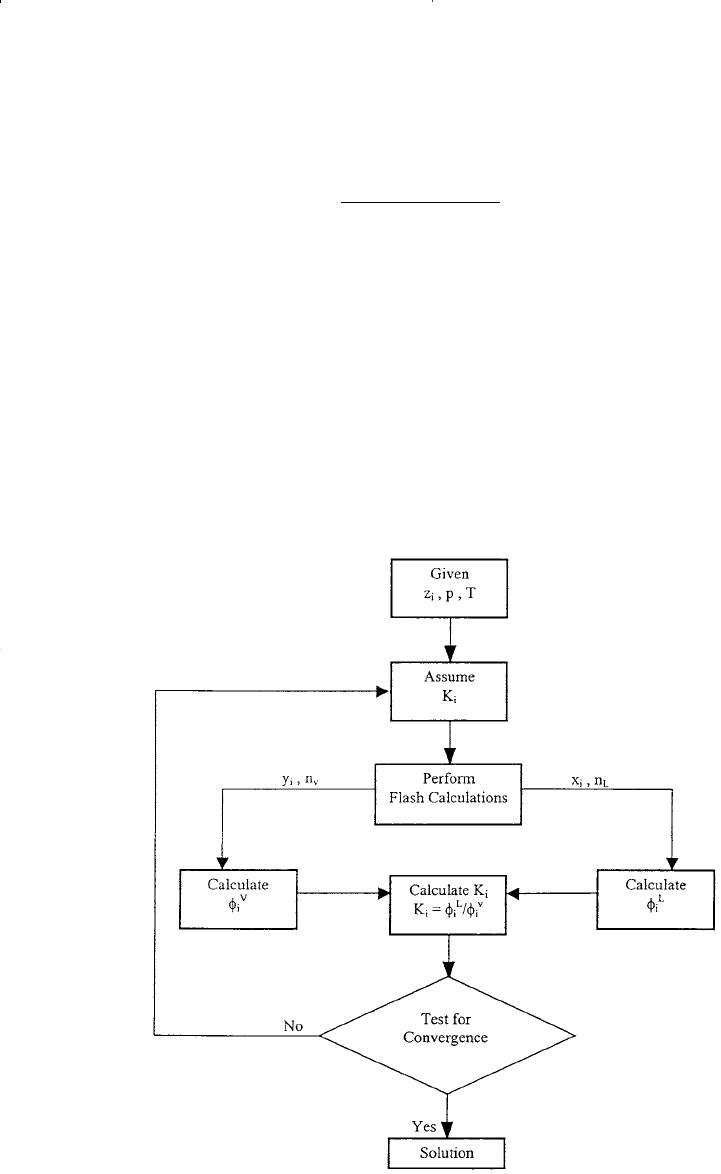Tarek Ahmed. Reservoir engineering handbook
Подождите немного. Документ загружается.


and
• For CO
2
-hydrocarbons:
and
For the CO
2
interaction parameters, the following pressure correc-
tion is suggested:
Stryjek and Vera (1986) proposed an improvement in the reproduction
of vapor pressures of pure components by the PR EOS in the reduced
temperature range from 0.7 to 1.0 by replacing the m term in Equation
15-111 with the following expression:
To reproduce vapor pressures at reduced temperatures below 0.7, Stryjek
and Vera further modified the m parameter in the PR equation by intro-
ducing an adjustable parameter m
1
characteristic of each compound to
Equation 15-111. They proposed the following generalized relationship
for the parameter m:
where T
r
= reduced temperature of the pure component
m
o
= defined by Equation 15-128
m
1
= adjustable parameter
For all components with a reduced temperature above 0.7, Stryjek and
Vera recommended setting m
1
= 0. For components with a reduced tem-
perature greater than 0.7, the optimum values of m
1
for compounds of
industrial interest are tabulated below:
mm m T T
rr
=+ +
(
)
−
(
)
[]
(
)
01
107. 15-129
m
0
23
0 378893 1 4897153 0 17131848 0 0196554=+ − +
(
)
.. . .ωω15 -128
′
=−×
(
)
(
)
−
kk p
ij ij
1 044269 4 375 10
5
. . 15 -127
δω
2
0 741843368 0 441775=+
(
)
(
)
. . log
j
15 -126
δω
δω
0
1
0 4025636 0 1748927
0 94812 0 6009864
=+
(
)
(
)
=− −
(
)
(
)
. . log
. . log
j
j
15 -124
15 -125
δωω
2
2
0 4114 3 5072 1 0783=− −
(
)
−
(
)
[]
(
)
. . log . log
ji
15 -123
1118 Reservoir Engineering Handbook
Reservoir Eng Hndbk Ch 15 2001-10-25 17:41 Page 1118

Parameter m
1
of Pure Compounds
Compound m
1
Compound m
1
Nitrogen 0.01996 Nonane 0.04104
Carbon dioxide 0.04285 Decane 0.04510
Water –0.06635 Undecane 0.02919
Methane –0.00159 Dodecane 0.05426
Ethane 0.02669 Tridecane 0.04157
Propane 0.03136 Tetradecane 0.02686
Butane 0.03443 Pentadecane 0.01892
Pentane 0.03946 Hexadecane 0.02665
Hexane 0.05104 Heptadecane 0.04048
Heptane 0.04648 Octadecane 0.08291
Octane 0.04464
Due to the totally empirical nature of the parameter m
1
, Stryjek and
Vera (1986) could not find a generalized correlation for m
1
in terms of
pure component parameters. They pointed out that the values of m
1
given
above should be used without changes.
Jhaveri and Youngren (1984) pointed out that when applying the
Peng–Robinson equation of state to reservoir fluids, the error associated
with the equation in the prediction of gas-phase Z factors ranged from 3
to 5%, and the error in the liquid density predictions ranged from 6 to
12%. Following the procedure proposed by Peneloux and coworkers (see
the SRK EOS), Jhaveri and Youngren introduced the volume correction
parameter c
i
to the PR EOS. This third parameter has the same units as
the second parameter b
i
of the unmodified PR equation and is defined by
the following relationship:
where S
i
= dimensionless parameter and is called the shift parameter
b
i
= Peng–Robinson co-volume as given by Equation 15-110
The volume correction parameter c
i
does not change the vapor-liquid
equilibrium conditions, i.e., equilibrium ratio K
i
. The corrected hydrocar-
bon phase volumes are given by the following expressions:
VV xc
VV yc
corr
LL
ii
i
corr
vv
ii
i
=−
(
)
=−
(
)
=
=
∑
∑
1
1
cSb
iii
=
(
)
15 -130
Vapor–Liquid Phase Equilibria 1119
Reservoir Eng Hndbk Ch 15 2001-10-25 17:41 Page 1119

where V
L
, V
v
= volumes of the liquid phase and gas phase as
calculated by unmodified PR EOS, ft
3
/mol
V
L
corr
, V
v
corr
= corrected volumes of the liquid and gas phase
Whitson and Brule (2000) point out that the volume translation (cor-
rection) concept can be applied to any two-constant cubic equation,
thereby eliminating the volumetric deficiency associated with application
of EOS. Whitson and Brule extended the work of Jhaveri and Youngren
(1984) and proposed the following shift parameters for selected pure
components:
Shift Parameters for the PR EOS and SRK EOS
Compound PR EOS SRK EOS
N
2
–0.1927 –0.0079
CO
2
–0.0817 0.0833
H
2
S –0.1288 0.0466
C
1
–0.1595 0.0234
C
2
–0.1134 0.0605
C
3
–0.0863 0.0825
i – C
4
–0.0844 0.0830
n – C
4
–0.0675 0.0975
i – C
5
–0.0608 0.1022
n – C
5
–0.0390 0.1209
n – C
6
–0.0080 0.1467
n – C
7
0.0033 0.1554
n – C
8
0.0314 0.1794
n – C
9
0.0408 0.1868
n – C
10
0.0655 0.2080
Jhaveri and Youngren (1984) proposed the following expression for
calculating the shift parameter for the C
7+
:
where M = molecular weight of the heptanes-plus fraction
d, e = positive correlation coefficients
The authors proposed that in the absence of the experimental information
needed for calculating e and d, the power coefficient e can be set equal to
0.2051 and the coefficient d adjusted to match the C
7+
density with the
values of d ranging from 2.2 to 3.2. In general, the following values may
be used for C
7+
fractions:
S
d
M
e
=−
(
)
1
1120 Reservoir Engineering Handbook
Reservoir Eng Hndbk Ch 15 2001-10-25 17:41 Page 1120

Hydrocarbon Family d e
Paraffins 2.258 0.1823
Naphthenes 3.044 0.2324
Aromatics 2.516 0.2008
To use the Peng and Robinson equation of state to predict the phase
and volumetric behavior of mixtures, one must be able to provide the
critical pressure, the critical temperature, and the acentric factor for each
component in the mixture. For pure compounds, the required properties
are well defined and known. Nearly all naturally occurring petroleum
fluids contain a quantity of heavy fractions that are not well defined.
These heavy fractions are often lumped together as the heptanes-plus
fraction. The problem of how to adequately characterize the C
7+
fractions
in terms of their critical properties and acentric factors has been long rec-
ognized in the petroleum industry. Changing the characterization of C
7+
fractions present in even small amounts can have a profound effect on
the PVT properties and the phase equilibria of a hydrocarbon system as
predicted by the Peng and Robinson equation of state.
The usual approach for such situations is to “tune” the parameters in
the EOS in an attempt to improve the accuracy of prediction. During the
tuning process, the critical properties of the heptanes-plus fraction and
the binary interaction coefficients are adjusted to obtain a reasonable
match with experimental data available on the hydrocarbon mixture.
Recognizing that the inadequacy of the predictive capability of the PR
EOS lies with the improper procedure for calculating the parameters a, b,
and α of the equation for the C
7+
fraction, Ahmed (1991) devised an
approach for determining these parameters from the following two readi-
ly measured physical properties of C
7+
: molecular weight, M
7+
, and spe-
cific gravity,
7+
.
The approach is based on generating 49 density values for the C
7+
by
applying the Riazi and Daubert correlation. These values were subse-
quently subjected to 10 temperature and 10 pressure values in the range
of 60 to 300°F and 14.7 to 7000 psia, respectively. The Peng and Robin-
son EOS was then applied to match the 4900 generated density values by
optimizing the parameters a, b, and α using a nonlinear regression model.
The optimized parameters for the heptanes-plus fraction are given by the
following expressions.
For the parameter a of C
7+
:
α= + −
(
)
11
520
2
m
T
[ ) 15 -131
Vapor–Liquid Phase Equilibria 1121
Reservoir Eng Hndbk Ch 15 2001-10-25 17:41 Page 1121

with m defined by:
with the parameter D defined by the ratio of the molecular weight to the
specific gravity of the heptanes-plus fraction, or:
where M
7+
= molecular weight of C
7+
7+
= specific gravity of C
7+
A
0
– A
7
= coefficients as given in Table 15-2
For the parameters a and b of C
7+
, the following generalized correla-
tion is proposed:
The coefficients A
0
through A
7
are included in Table 15-2.
To further improve the predictive capability of the Peng–Robinson
EOS, the author optimized coefficients a, b, and m for nitrogen, CO
2
, and
methane by matching 100 Z-factor values for each of these components.
Using a nonlinear regression model, the following optimized values are
recommended:
Table 15-2 Coefficients for Equations 15-132 and 15-133
Coefficient a b m
A
0
–2.433525 × 10
7
–6.8453198 –36.91776
A
1
8.3201587 × 10
3
1.730243 × 10
–2
–5.2393763 × 10
–2
A
2
–0.18444102 × 10
2
–6.2055064 × 10
–6
1.7316235 × 10
–2
A
3
3.6003101 × 10
–2
9.0910383 × 10
–9
–1.3743308 × 10
–5
A
4
3.4992796 × 10
7
13.378898 12.718844
A
5
2.838756 × 10
7
7.9492922 10.246122
A
6
–1.1325365 × 10
7
–3.1779077 –7.6697942
A
7
6.418828 × 10
6
1.7190311 –2.6078099
aorb AD
A
D
A
A
i
i
i
i
i
i
=
(
)
+
(
)
+
(
)
=
+
−
=
+
∑∑
0
3
4
7
4
5
6
7
7
γ
γ
, 15 -133
D
M
=
+
+
7
7
γ
m
D
AAD
AM AM
A
M
A
A
A
=
+
++++
++
(
)
++
+
+
+
+
01
27 37
2
4
7
5
7
67
2
7
7
γ
γ
γ
15 -132
1122 Reservoir Engineering Handbook
Reservoir Eng Hndbk Ch 15 2001-10-25 17:41 Page 1122

Component a b m in Eq. 15-131
CO
2
1.499914 × 10
4
0.41503575 –0.73605717
N
2
4.5693589 × 10
3
0.4682582 –0.97962859
C
1
7.709708 × 10
3
0.46749727 –0.549765
To provide the modified PR EOS with a consistent procedure for
determining the binary interaction coefficient k
ij
, the following computa-
tional steps are proposed:
Step 1. Calculate the binary interaction coefficient between methane and
the heptanes-plus fraction from:
where the temperature T is in °R.
Step 2. Set:
k
CO
2
–N
2
= 0.12
k
CO
2
-hydrocarbon
= 0.10
k
N
2
- hydrocarbon
= 0.10
Step 3. Adopting the procedure recommended by Petersen (1989), calcu-
late the binary interaction coefficients between components heav-
ier than methane (e.g., C
2
, C
3
) and the heptanes-plus fraction from:
where n is the number of carbon atoms of component C
n
; e.g.:
Binary interaction coefficient between C
2
and C
7+
is
k
C
2
– C
7+
= 0.8 k
C
1
– C
7+
Binary interaction coefficient between C
3
and C
7+
is
k
C
3
– C
7+
= 0.8 k
C
2
– C
7+
Step 4. Determine the remaining k
ij
from:
where M is the molecular weight of any specified component.
For example, the binary interaction coefficient between propane
C
3
and butane C
4
is:
kk
MM
MM
ij i C
ji
Ci
=
(
)
−
(
)
(
)
−
(
)
−
+
+
7
7
5
5
5
5
kk
CC C C
n
n
−−
+
−
()
+
=
7
1
7
08.
kT
cc
17
0 00189 1 167059
−
+
=−..
Vapor–Liquid Phase Equilibria 1123
Reservoir Eng Hndbk Ch 15 2001-10-25 17:41 Page 1123

APPLICATIONS OF THE EQUATION OF STATE IN
PETROLEUM ENGINEERING
Determination of the Equilibrium Ratios
A flow diagram is presented in Figure 15-14 to illustrate the procedure
of determining equilibrium ratios of a hydrocarbon mixture. For this type
of calculation, the system temperature T, the system pressure p, and the
overall composition of the mixture z
i
must be known. The procedure is
summarized in the following steps in conjunction with Figure 15-14.
Figure 15-14. Flow diagram of the equilibrium ratio determination by an equa-
tion of state.
kk
MM
MM
CC CC
CC
CC
34 37
43
73
5
5
55
−−
=
(
)
−
(
)
(
)
−
(
)
+
+
1124 Reservoir Engineering Handbook
Reservoir Eng Hndbk Ch 15 2001-10-25 17:41 Page 1124

Step 1. Assume an initial value of the equilibrium ratio for each compo-
nent in the mixture at the specified system pressure and tempera-
ture. Wilson’s equation can provide the starting K
i
values.
where K
A
i
= assumed equilibrium ratio of component i.
Step 2. Using the overall composition and the assumed K values, per-
form flash calculations to determine x
i
, y
i
, n
L
, and n
v
.
Step 3. Using the calculated composition of the liquid phase x
i
, deter-
mine the fugacity coefficient Φ
L
i
for each component in the liquid
phase.
Step 4. Repeat Step 3 using the calculated composition of the gas phase
y
i
to determine Φ
v
i
.
Step 5. Calculate the new set of equilibrium ratios from:
Step 6. Check for the solution by applying the following constraint:
where ε = preset error tolerance, e.g., 0.0001
n = number of components in the system
If the above conditions are satisfied, then the solution has been reached.
If not, steps 1 through 6 are repeated by using the calculated equilibrium
ratios as initial values.
Determination of the Dew-Point Pressure
A saturated vapor exists for a given temperature at the pressure at
which an infinitesimal amount of liquid first appears. This pressure is
referred to as the dew-point pressure p
d
. The dew-point pressure of a
mixture is described mathematically by the following two conditions:
KK
i
i
A
i
n
/ −
[]
≤
=
∑
1
2
1
ε
K
i
i
L
i
v
=
Φ
Φ
K
p
p
TT
i
A
ci
ici
=+
(
)
−
(
)
[]
exp . /5371 1ω
Vapor–Liquid Phase Equilibria 1125
Reservoir Eng Hndbk Ch 15 2001-10-25 17:41 Page 1125

and:
Applying the definition of K
i
in terms of the fugacity coefficient to Equa-
tion 15-135 gives:
or
The above equation is arranged to give:
where p
d
= dew-point pressure, psia
f
v
i
= fugacity of component i in the vapor phase, psia
Φ
L
i
= fugacity coefficient of component i in the liquid phase
Equation 15-136 can be solved for the dew-point pressure by using the
Newton–Raphson iterative method. To use the iterative method, the
derivative of Equation 15-136 with respect to the dew-point pressure p
d
is required. This derivative is given by the following expression:
The two derivatives in the above equation can be approximated numeri-
cally as follows:
∂
∂
=
+
(
)
−−
(
)
(
)
f
p
fp p fp p
p
v
d
i
v
dd
i
v
dd
d
∆∆
∆2
15 -138
∂
∂
=
∂∂
(
)
−∂ ∂
(
)
(
)
−
(
)
=
∑
f
p
fp f p
d
i
L
i
v
d
i
v
i
L
d
i
L
i
n
ΦΦ
Φ
//
2
1
1 15 -137
fp
f
p
d
i
v
i
L
d
i
n
(
)
=
−=
(
)
=
∑
Φ
1
0 15 -136
p
f
d
i
v
i
L
i
n
=
=
∑
Φ
1
z
k
zzf
zp
i
i
i
i
L
i
v
i
n
i
n
i
i
L
i
v
id
=
(
)
=
=
==
∑∑∑
ΦΦ
Φ
/
11
1
z
K
i
i
i
n
=
(
)
−
∑
1
1
15 -135
yz in
n
ii
v
=≤≤
(
)
=
1
1
15 -134
1126 Reservoir Engineering Handbook
Reservoir Eng Hndbk Ch 15 2001-10-25 17:41 Page 1126

and
where ∆p
d
= pressure increment, 5 psia, for example
f
v
i
(p
d
+ ∆p
d
) = fugacity of component i at (p
d
+ ∆p
d
)
f
v
i
(p
d
– ∆p
d
) = fugacity of component i at (p
d
– ∆p
d
)
Φ
L
i
(p
d
+ ∆p
d
) = fugacity coefficient of component i at
(p
d
+ ∆p
d
)
Φ
L
i
(p
d
– ∆p
d
) = fugacity coefficient of component i at
(p
d
– ∆p
d
)
Φ
L
i
= fugacity coefficient of component i at p
d
The computational procedure of determining p
d
is summarized in the
following steps:
Step 1. Assume an initial value for the dew-point pressure p
A
d
.
Step 2. Using the assumed value of p
A
d
,
calculate a set of equilibrium
ratios for the mixture by using any of the previous correlations,
e.g., Wilson’s correlation.
Step 3. Calculate the composition of the liquid phase, i.e., composition
of the droplets of liquid, by applying the mathematical definition
of K
i
, to give:
Note that y
i
= z
i
.
Step 4. Calculate f
v
i
using the composition of the gas phase z
i
and Φ
L
i
using the composition of liquid phase x
i
at the following three
pressures:
•p
A
d
•p
A
d
+ p
d
,
•p
A
d
– p
d
where p
A
d
is the assumed dew-point pressure and ∆p
d
is a
selected pressure increment of 5 to 10 psi.
x
z
K
i
i
i
=
∂
∂
=
+
(
)
−−
(
)
(
)
f
p
pp pp
p
i
L
d
i
L
dd
i
L
dd
d
Φ∆Φ∆
∆2
15 -139
Vapor–Liquid Phase Equilibria 1127
Reservoir Eng Hndbk Ch 15 2001-10-25 17:41 Page 1127
